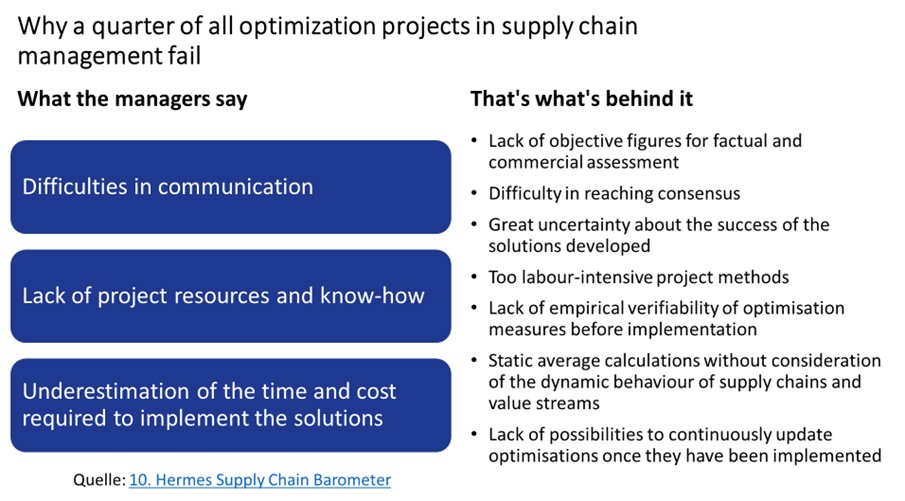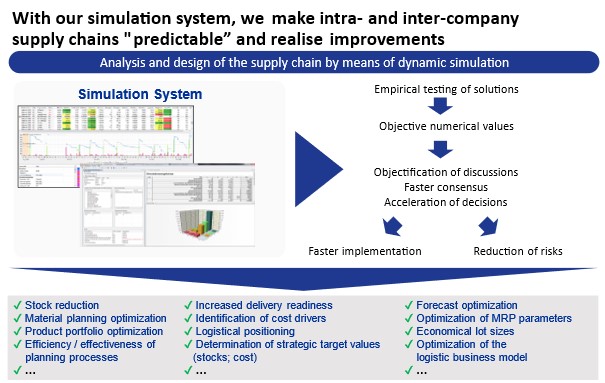The challenges in supply chain management of the future cannot be mastered with outdated consulting methods.
We live in exciting times with massive challenges in our supply chains. Uncertain procurement sources and channels, uncertain demand, shifting procurement and sales markets, rising manufacturing and transport costs, challenging CO2 reduction targets, staff, material and capacity bottlenecks, extended delivery times; the list goes on and on.
All these challenges put massive pressure on the productivity of our value chains and supply chains. Yet, we urgently need to work on increasing productivity in order to keep up with international competition.
No wonder that many companies are planning projects to optimize their value and supply chains. Already in May 2019, the 10th Hermes Supply Chain Barometer showed that 78 % of German companies are systematically working on supply chain optimization. However, it revealed that, in companies with over 250 employees, 23 % of optimization projects were abandoned due to a lack of success. In the meantime, the need for action has increased further, but so has the dimension of the challenges. So, more companies are likely to be working on supply chain optimization and an even larger percentage of projects are likely to fail.
In its study, Hermes points to three main causes of failure:
- Communication difficulties
- Lack of resources for the project and lack of know-how
- Underestimation of the time and cost required to implement the solutions.
The reasons given are very much in line with what we hear in conversations with business leaders, operations and supply chain managers. But in most cases, the reasons stated are only the symptoms of underlying causes:
Communication difficulties can be avoided through objective figures
Different opinions quickly arise between different departments, company locations or companies, even if the common goal is clear. Here it helps to objectify the discussion by evaluating the targeted optimization measures with objective figures.
Lack of project resources and know-how can be effectively compensated for by workshop-based project work.
In our complex world, lack of know-how is no disgrace. This is where external consultants like us can provide support. This also applies to the issue of resources, but for this, external consultants are very expensive, and an internal project team is still necessary, because external consultants should not and are not allowed to decide and implement everything on their own.
With the right project methodology, however, a team of consultants and internal staff can carry out an optimisation projects in logistics and supply chain management, so that it can be managed by the internal team largely alongside day-to-day business without increasing external costs. For this to happen, the project must be workshop-based and the tasks between consultants and company staff must be split in such a way that options for action are discussed and reviewed in the workshops, which are then elaborated and quantified by the consultants until the next workshop.
Time and costs for the implementation of solutions can be massively reduced through simulation in a digital twin.
In many optimization projects in logistics and supply chain management, value streams must be considered, and changes made to the value stream model, planning and control mechanisms, warehouse levels, inventory distribution and much more. In a classic project approach, this is tedious, time-consuming and costly. It already starts with the collection of data. Attempting to compare alternative solutions using static calculations that do not consider the time dynamics of the events in the value and supply chain, will deliver uncertain and questionable results.
A quick implementation of the developed solutions is risky and one reason for the failure of optimisation projects in logistics and supply chain management. A cautious implementation of the elaborated solutions, for example by first feeling one’s way with a few articles or a product group or by only implementing a small part of the necessary adjustments, takes a lot of time and can lead to the activities becoming bogged down. If there is no end to the project and no clear successes can be seen, the motivation of the project staff quickly decreases.
The challenge of cost and time can be met very elegantly with modern analysis and optimization methods: We carry out such optimization projects using a digital twin in which we map the entire value and supply chain. The necessary data can be transferred from ERP or inventory management systems. Such a digital twin contains all articles, semi-finished products and raw materials and not just a supposedly representative selection. In a simulation mechanism, the entire behaviour in the digital twin can be mapped and reproduced over the dynamic course of time. Different alternatives for action can thus be considered in detail, reliably evaluated, and improved in a differentiated manner. The analysis and conception phase can thus be carried out quickly and efficiently, and risks can be identified and eliminated in advance. The implementation can then proceed swiftly, as the necessary adaptation measures are known in detail and have been tested beforehand.
Only by means of a digital twin can success be ensured in the long term
And what’s more: conditions are constantly changing, which is why the structure of the supply chains, and their planning and control mechanisms must also be constantly adapted and readjusted. Optimization is never over. The optimization leap of the initial project must be followed by continuous maintenance and care. A digital twin allows adjustments to be tested quickly, efficiently, and reliably and thus implemented fast; an essential condition for ensuring that value and supply chains are always optimally adjusted and that productivity effects are not lost again after a short time.
Optimising value flows and supply chains or planning and control strategies by means of empirical simulation in a digital twin allows improvement measures to be reliably identified, quickly implemented and, if necessary, easily readjusted. None of our optimisation projects have failed so far, and you too will succeed too – take heart!



